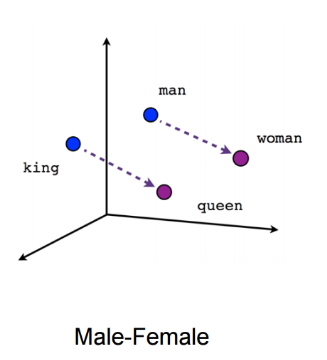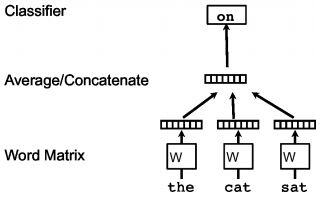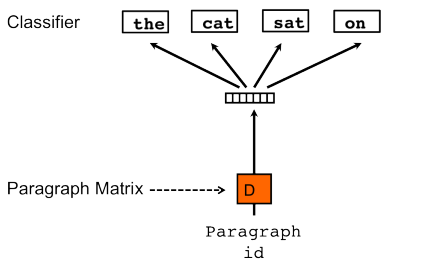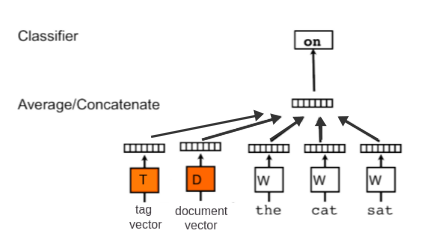TL;DR
In this post you will learn what is doc2vec, how it?s built, how it?s related to word2vec, what can you do with it, hopefully with no mathematic formulas.
Want to learn more? visit www.shibumi-ai.com
Intro
Numeric representation of text documents is a challenging task in machine learning. Such a representation may be used for many purposes, for example: document retrieval, web search, spam filtering, topic modeling etc.
However, there are not many good techniques to do this. Many tasks use the well known but simplistic method of bag of words (BOW), but outcomes will be mostly mediocre, since BOW loses many subtleties of a possible good representation, e.g consideration of word ordering.
Latent Dirichlet Allocation (LDA) is also a common technique for topic modeling (extracting topics/keywords out of texts) but it?s very hard to tune, and results are hard to evaluate.
In this post, I will review the doc2vec method, a concept that was presented in 2014 by Mikilov and Le in this article, which we are going to mention many times through this post. Worth to mention that Mikilov is one of the authors of word2vec as well.
Doc2vec is a very nice technique. It?s easy to use, gives good results, and as you can understand from its name, heavily based on word2vec. so we?ll start with a short introduction about word2vec.
word2vec
word2vec is a well known concept, used to generate representation vectors out of words.
There are many good tutorials online about word2vec, like this one and this one, but describing doc2vec without word2vec will miss the point, so I?ll be brief.
In general, when you like to build some model using words, simply labeling/one-hot encoding them is a plausible way to go. However, when using such encoding, the words lose their meaning. e.g, if we encode Paris as id_4, France as id_6 and power as id_8, France will have the same relation to power as with Paris. We would prefer a representation in which France and Paris will be closer than France and power.
The word2vec, presented in 2013 in this article, intends to give you just that: a numeric representation for each word, that will be able to capture such relations as above. this is part of a wider concept in machine learning ? the feature vectors.
Such representations, encapsulate different relations between words, like synonyms, antonyms, or analogies, such as this one:
 fig 1: king to queen is like man to woman. it is illegal to write about word2vec without attaching this plot
fig 1: king to queen is like man to woman. it is illegal to write about word2vec without attaching this plot
Word2vec algorithms
So how is it done? word2vec representation is created using 2 algorithms: Continuous Bag-of-Words model (CBOW) and the Skip-Gram model.
Continuous bag of words
Continuous bag of words creates a sliding window around current word, to predict it from ?context? ? the surrounding words. Each word is represented as a feature vector. After training, these vectors become the word vectors.
 fig 2: CBOW algorithm sketch: the words ?the? ?cat? ?sat? are used to predict the word ?on?
fig 2: CBOW algorithm sketch: the words ?the? ?cat? ?sat? are used to predict the word ?on?
As said before, vectors which represent similar words are close by different distance metrics, and additioanly encapsualte numeric relations, such as the king-queen=man from above.
Skip gram
The second algorithm (described in the same article, and well explaiend here) is actaully the opposite of CBOW: instead of prediciting one word each time, we use 1 word to predict all surrounding words (?context?). Skip gram is much slower than CBOW, but considered more accurate with infrequent words.
Doc2vec
After hopefully understanding what word2vec is, it will be easier to understand how doc2vec works.
As said, the goal of doc2vec is to create a numeric representation of a document, regardless of its length. But unlike words, documents do not come in logical structures such as words, so the another method has to be found.
The concept that Mikilov and Le have used was simple, yet clever: they have used the word2vec model, and added another vector (Paragraph ID below), like so:
 fig 3: PV-DM model
fig 3: PV-DM model
If you feel familiar with the sketch above, it?s because it is a small extension to the CBOW model. But instead of using just words to predict the next word, we also added another feature vector, which is document-unique.
So, when training the word vectors W, the document vector D is trained as well, and in the end of training, it holds a numeric representation of the document.
The model above is called Distributed Memory version of Paragraph Vector (PV-DM). It acts as a memory that remembers what is missing from the current context ? or as the topic of the paragraph. While the word vectors represent the concept of a word, the document vector intends to represent the concept of a document.
As in word2vec, another algorithm, which is similar to skip-gram may be used Distributed Bag of Words version of Paragraph Vector (PV-DBOW)
 fig 4: PV-DBOW model
fig 4: PV-DBOW model
Here, this algorithm is actually faster (as opposed to word2vec) and consumes less memory, since there is no need to save the word vectors.
In the article, the authors state that they recommend using a combination of both algorithms, though the PV-DM model is superior and usually will achieve state of the art results by itself.
The doc2vec models may be used in the following way: for training, a set of documents is required. A word vector W is generated for each word, and a document vector D is generated for each document. The model also trains weights for a softmax hidden layer. In the inference stage, a new document may be presented, and all weights are fixed to calculate the document vector.
Evaluating model and some thoughts
The thing with this kind of unsupervised models, is that they are not trained to do the task they are intended for. E.g, word2vec is trained to complete surrounding words in corpus, but is used to estimate similarity or relations between words. As such, measuring the performance of these algorithms may be challenging. We already saw the king ,queen,man, woman example, but we want to make form it a rigorous way to evaluate machine learning models.
Therefore, when training these algorithms, we should be minded to relevant metrics. One possible metric for word2vec, is a generalization of the above example, and is called analogical reasoning. It contains many analogical combinations, here are some:
- happy happily ? furious furiously
- immediate immediately ? infrequent infrequently
- slowing slowed ? sleeping slept
- spending spent ? striking struck
A success in this task is getting very close results when caclulating distances between matching pairs.
Dataset is availible at http://download.tensorflow.org/data/questions-words.txt.
Doc2vec was tested in the article on 2 tasks: the first is sentiment analysis, and the second one is similar to the analogical reasoning above.
Here are 3 paragraphs from the article. a dataset of such paragraphs was used to compare models. it is easy to see which 2 should be closer:


This dataset (was not shared as far as I know) was used to compare some models, and doc2vec came out as the best:

Real life challenge ? Wisio
One of my clients, Wisio, uses machine learning methods to match ?influencer? you-tube videos to content-articles. Doc2vec seems to be a great method for such match.
Here is an example for what the Wisio does: in this article, about home made lights in a tree stump, you may see at the bottom 4 related video about woodworking stuff:
 Wisio?s recommended videos for the above article
Wisio?s recommended videos for the above article
Wisio?s current model uses tagging mechanism to tag the videos and the articles (?topic modeling?) and measuring distance between tags.
Wisio has a few corpora of text, related to the themes of its? clients. E.g, there is a 100K manually tagged documents about ?do it yourself?, for publishers such as above. There are 17 possible tags for each article (e.g, ?home decor?, ?gardening?, ?remodeling and renovating? etc.). For this experiment, we decided trying to predict the tags using doc2vec and some other models.
Wisio?s current best model was a convolutional neural network, on top of word2vec, which achieved accuracy of around 70% in predicting the tags for the documents (as described here).
Doc2vec model by itself is an unsupervised method, so it should be tweaked a little bit to ?participate? in this contest. Fortunately, as in most cases, we can use some tricks: If you recall, in fig 3 we added another document vector, which was unique for each document. If you think about it, it is possible to add more vectors, which don?t have to be unique: for example, if we have tags for our documents (as we actually have), we can add them, and get their representation as vectors.
Additionally, they don?t have to be unique. This way, we can add to the unique document tag one of our 17 tags, and create a doc2vec representation for them as well! see below:
 fig 5 ? doc2vec model with tag vector
fig 5 ? doc2vec model with tag vector
we will use gensim implementation of doc2vec. here is how the gensim TaggedDocument object looks like:
 gensim TaggedDocument object. SENT_3 is the unique document id, remodeling and renovating is the tag
gensim TaggedDocument object. SENT_3 is the unique document id, remodeling and renovating is the tag
Using gensim doc2vec is very straight-forward. As always, model should be initialized, trained for a few epochs:

and then we can check the similarity of every unique document to every tag, this way:

The tag with highest similarity to document will be predicted.
Using this method, with training only on 10K out of our 100K articles, we have reached accuracy of 74%, better than before.
Summary
We have seen that with some tweaking, we can get much more from an already very useful word2vec model. This is great, because as said before, in my opinion representation of documents for tagging and matching has still a way to go.
Additionally, this shows that this is a great example for how machine learning models encapsulate much more abilities besides the specific task they were trained for. This can be seen in deep CNNs, which are trained for object classification, but can also be used for semantic segmentation or clustering images.
To conclude, if you have some document related task ? this may be great model for you!
Feel free to comment and correct. if there will be enough interest, I?ll share the code.
Enjoyed the article? Want learn more? visit www.shibumi-ai.com
or: Gidi Shperber

